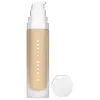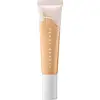Fenty Beauty Soft’Lit Naturally Luminous Longwear Foundation Versus Fenty Beauty Pro Filt'r Hydrating Longwear Foundation
What's inside
What's inside
 Key Ingredients
Key Ingredients

 Benefits
Benefits

 Concerns
Concerns

 Ingredients Side-by-side
Ingredients Side-by-side

Water
Skin ConditioningDimethicone
EmollientButylene Glycol Dicaprylate/Dicaprate
EmollientDiphenylsiloxy Phenyl Trimethicone
Skin ConditioningGlycerin
HumectantSynthetic Fluorphlogopite
Cetyl PEG/PPG-10/1 Dimethicone
EmulsifyingTrisiloxane
Skin ConditioningButylene Glycol
Humectant1,2-Hexanediol
Skin ConditioningTrimethylsiloxysilicate
EmollientDisteardimonium Hectorite
StabilisingPEG-10 Dimethicone
Skin ConditioningPolyphenylsilsesquioxane
Magnesium Sulfate
Dimethicone Crosspolymer
Emulsion StabilisingLauroyl Lysine
Skin ConditioningTriethoxycaprylylsilane
Aluminum Hydroxide
EmollientPolyhydroxystearic Acid
EmulsifyingEthylhexyl Palmitate
EmollientIsopropyl Myristate
EmollientIsostearic Acid
CleansingLecithin
EmollientTerminalia Ferdinandiana Fruit Extract
AntioxidantTrisodium Ethylenediamine Disuccinate
Polyglyceryl-3 Polyricinoleate
EmulsifyingCyperus Rotundus Root Extract
Skin ConditioningCI 77891
Cosmetic ColorantIron Oxides
Water, Dimethicone, Butylene Glycol Dicaprylate/Dicaprate, Diphenylsiloxy Phenyl Trimethicone, Glycerin, Synthetic Fluorphlogopite, Cetyl PEG/PPG-10/1 Dimethicone, Trisiloxane, Butylene Glycol, 1,2-Hexanediol, Trimethylsiloxysilicate, Disteardimonium Hectorite, PEG-10 Dimethicone, Polyphenylsilsesquioxane, Magnesium Sulfate, Dimethicone Crosspolymer, Lauroyl Lysine, Triethoxycaprylylsilane, Aluminum Hydroxide, Polyhydroxystearic Acid, Ethylhexyl Palmitate, Isopropyl Myristate, Isostearic Acid, Lecithin, Terminalia Ferdinandiana Fruit Extract, Trisodium Ethylenediamine Disuccinate, Polyglyceryl-3 Polyricinoleate, Cyperus Rotundus Root Extract, CI 77891, Iron Oxides
Water
Skin ConditioningTalc
AbrasivePhenyl Trimethicone
Skin ConditioningC12-15 Alkyl Benzoate
AntimicrobialCaprylyl Methicone
Skin ConditioningPEG-10 Dimethicone
Skin ConditioningTrimethylsiloxyphenyl Dimethicone
Dimethicone
EmollientGlycerin
HumectantIsododecane
EmollientCetyl PEG/PPG-10/1 Dimethicone
EmulsifyingDimethicone/Vinyl Dimethicone Crosspolymer
Skin ConditioningPhenoxyethanol
PreservativeSodium Chloride
MaskingHydrogen Dimethicone
Magnesium Sulfate
Sodium Dehydroacetate
PreservativePotassium Sorbate
PreservativeAluminum Hydroxide
EmollientDisteardimonium Hectorite
StabilisingBenzoic Acid
MaskingSodium Hyaluronate
HumectantDehydroacetic Acid
PreservativePropylene Carbonate
SolventParfum
MaskingCaprylic/Capric Triglyceride
MaskingEthylhexylglycerin
Skin ConditioningVitis Vinifera Seed Oil
EmollientMorus Alba Bark Extract
Skin ConditioningMethicone
EmollientTriethoxycaprylylsilane
CI 77891
Cosmetic ColorantIron Oxides
Water, Talc, Phenyl Trimethicone, C12-15 Alkyl Benzoate, Caprylyl Methicone, PEG-10 Dimethicone, Trimethylsiloxyphenyl Dimethicone, Dimethicone, Glycerin, Isododecane, Cetyl PEG/PPG-10/1 Dimethicone, Dimethicone/Vinyl Dimethicone Crosspolymer, Phenoxyethanol, Sodium Chloride, Hydrogen Dimethicone, Magnesium Sulfate, Sodium Dehydroacetate, Potassium Sorbate, Aluminum Hydroxide, Disteardimonium Hectorite, Benzoic Acid, Sodium Hyaluronate, Dehydroacetic Acid, Propylene Carbonate, Parfum, Caprylic/Capric Triglyceride, Ethylhexylglycerin, Vitis Vinifera Seed Oil, Morus Alba Bark Extract, Methicone, Triethoxycaprylylsilane, CI 77891, Iron Oxides
 Reviews
Reviews

Ingredients Explained
These ingredients are found in both products.
Ingredients higher up in an ingredient list are typically present in a larger amount.
Aluminum Hydroxide is a form of aluminum. It can be naturally found in nature as the mineral gibbsite. In cosmetics, Aluminum Hydroxide is used as a colorant, pH adjuster, and absorbent.
As a colorant, Aluminum Hydroxide may add opacity, or reduce the transparency. Aluminum hydroxide is contains both basic and acidic properties.
According to manufacturers, this ingredient is an emollient and humectant. This means it helps hydrate the skin.
In medicine, this ingredient is used to help relieve heartburn and help heal ulcers.
There is currently no credible scientific evidence linking aluminum hydroxide in cosmetics to increased cancer risk.
Major health organizations allow the use of aluminum hydroxide in personal care products and have not flagged it as a carcinogenic risk at typical usage levels.
Learn more about Aluminum HydroxideThis ingredient is a high molecular weight silicone. It has emulsifying and skin conditioning properties.
Ci 77891 is a white pigment from Titanium dioxide. It is naturally found in minerals such as rutile and ilmenite.
It's main function is to add a white color to cosmetics. It can also be mixed with other colors to create different shades.
Ci 77891 is commonly found in sunscreens due to its ability to block UV rays.
Learn more about CI 77891Dimethicone is a type of synthetic silicone created from natural materials such as quartz.
What it does:
Dimethicone comes in different viscosities:
Depending on the viscosity, dimethicone has different properties.
Ingredients lists don't always show which type is used, so we recommend reaching out to the brand if you have questions about the viscosity.
This ingredient is unlikely to cause irritation because it does not get absorbed into skin. However, people with silicone allergies should be careful about using this ingredient.
Note: Dimethicone may contribute to pilling. This is because it is not oil or water soluble, so pilling may occur when layered with products. When mixed with heavy oils in a formula, the outcome is also quite greasy.
Learn more about DimethiconeDisteardimonium Hectorite comes from the clay mineral named hectorite. It is used to add thickness to a product.
It can also help stabilize a product by helping to disperse other ingredients.
Hectorite is a rare, white clay mineral.
Learn more about Disteardimonium HectoriteGlycerin is already naturally found in your skin. It helps moisturize and protect your skin.
A study from 2016 found glycerin to be more effective as a humectant than AHAs and hyaluronic acid.
As a humectant, it helps the skin stay hydrated by pulling moisture to your skin. The low molecular weight of glycerin allows it to pull moisture into the deeper layers of your skin.
Hydrated skin improves your skin barrier; Your skin barrier helps protect against irritants and bacteria.
Glycerin has also been found to have antimicrobial and antiviral properties. Due to these properties, glycerin is often used in wound and burn treatments.
In cosmetics, glycerin is usually derived from plants such as soybean or palm. However, it can also be sourced from animals, such as tallow or animal fat.
This ingredient is organic, colorless, odorless, and non-toxic.
Glycerin is the name for this ingredient in American English. British English uses Glycerol/Glycerine.
Learn more about GlycerinMagnesium Sulfate is a salt. More specifically, it is an epsom salt, or the bath salt used to help relieve muscle aches.
Despite having ‘sulfate’ in the name, it isn’t a surfactant or cleansing agent like sodium lauryl sulfate. Unlike those sulfates, magnesium sulfate doesn’t have the same cleansing or foaming properties (it's simply a type of salt).
In cosmetics, Magnesium Sulfate is used to thicken a product or help dilute other solids. It is a non-reactive and non-irritating ingredient.
One study shows magnesium deficiency may lead to inflammation of the skin. Applying magnesium topically may help reduce inflammation.
You can find this ingredient in sea water or mineral deposits.
Learn more about Magnesium SulfatePeg-10 Dimethicone is silicone with conditioner and emulsifier properties. It mostly acts as an emollient in skincare and and humectant in haircare.
According to the manufacturer, acidic formulations decrease the stability of this ingredient. It works best in neutral or near neutral formulations.
Triethoxycaprylylsilane is a silicone used to bind and stabilize ingredients.
As an emulsifier, it helps prevent ingredients from separating. This can help elongate the shelf life of products.
Triethoxycaprylylsilane is often used to coat mineral sunscreens ingredients to help give a better feel. It also helps reduce oxidative stress in sunscreens.
Learn more about TriethoxycaprylylsilaneWater. It's the most common cosmetic ingredient of all. You'll usually see it at the top of ingredient lists, meaning that it makes up the largest part of the product.
So why is it so popular? Water most often acts as a solvent - this means that it helps dissolve other ingredients into the formulation.
You'll also recognize water as that liquid we all need to stay alive. If you see this, drink a glass of water. Stay hydrated!
Learn more about WaterThis ingredient is a combination of red, black, and yellow iron oxide pigments. This combination of colors is usually found in foundation, because it results in a "skin" color.